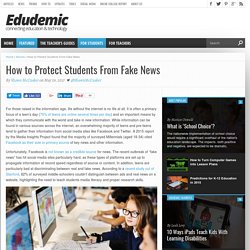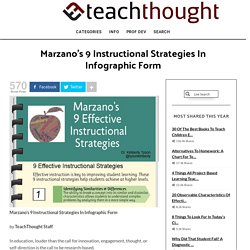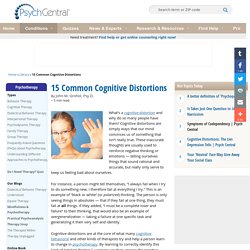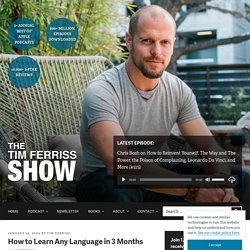

Met4u. MET. ANIDROC Lessons. Ultimate Guide to Note Taking in Class. How to Protect Students From Fake News. For those raised in the information age, life without the internet is no life at all.

It is often a primary focus of a teen’s day (75% of teens are online several times per day) and an important means by which they communicate with the world and take in new information. While information can be found in various sources across the internet, an overwhelming majority of teens and pre-teens tend to gather their information from social media sites like Facebook and Twitter. A 2015 report by the Media Insights Project found that the majority of surveyed Millennials (aged 18-34) cited Facebook as their sole or primary source of key news and other information. Unfortunately, Facebook is not known as a credible source for news. The recent outbreak of “fake news” has hit social media sites particularly hard, as these types of platforms are set up to propagate information at record speed regardless of source or content. Why Fake News is Dangerous How to Spot Fake News Further Reading. Teaching Methods - Lessons - Tes Teach. 321 Free Tools for Teachers - Free Educational Technology - eLearning Industry.
Marzano's 9 Instructional Strategies In Infographic Form. Marzano’s 9 Instructional Strategies In Infographic Form by TeachThought Staff In education, louder than the call for innovation, engagement, thought, or self-direction is the call to be research-based.

In fact, being research-based may even trump being data-based, the two twins of modern ed reform. The former stems, in part, from deserved skepticism of trends that have little evidence of performance, and the latter comes from a similar place. Differentiation Isn’t Perfect — But It Can Work. Differentiated instruction inspires love in some educators and loathing in others.

In a recent editorial for Education Week, educational consultant James Delisle came down firmly on the loathing side. He said that “differentiation in practice is harder to implement in a heterogeneous classroom than it is to juggle with one arm tied behind your back.” Let’s set passions aside for a moment and address two important questions. Does differentiation work for students? And is there any way that teachers can implement it while maintaining their sanity?
Image via Flickr by Lexie Flickinger One-Size-Fits-All Education is Falling Short The typical teacher has 30 students with abilities that span multiple grade levels. Delivering Differentiated Instruction in Your Classroom. As the Association for Supervision and Curriculum Development points out, today’s educators face a catch-22 — they must “help decidedly unstandardized students meet an expanding set of rigorous, standardized learning targets.”

Fortunately, teachers have a solution to this dilemma in differentiated instruction. A differentiated classroom accommodates the heterogeneity of students by tailoring instruction to each student’s backgrounds, interests, skill, and readiness levels. Read on to learn more about differentiated teaching, why it works, and how to implement it in your classroom.
Photo credit: Ethan Hein Defining Differentiated Instruction Carol Ann Tomlinson, author of “The Differentiated Classroom: Responding to the Needs of All Learners,” is the country’s preeminent scholar on differentiated instruction. Tomlinson identifies four curriculum-related elements that teachers can modify according to students’ needs: content, process, product, and affect. Global Digital Citizen Foundation. These 7 Strategies Help You Reach Challenging Students More Effectively One of the most common tasks we have as educators is trying to reach challenging students.

It will happen to all teachers of all levels eventually. 15 Common Cognitive Distortions. What’s a cognitive distortion and why do so many people have them?

Cognitive distortions are simply ways that our mind convinces us of something that isn’t really true. These inaccurate thoughts are usually used to reinforce negative thinking or emotions — telling ourselves things that sound rational and accurate, but really only serve to keep us feeling bad about ourselves. For instance, a person might tell themselves, “I always fail when I try to do something new; I therefore fail at everything I try.” Patterns of Thinking. The recently completed Patterns of Thinking project was a multi-year project.

The project's focus is the understanding, teaching, and assessment of thinking dispositions. Traditionally, good thinking has been defined as a matter of cognitive ability or skill. Hence the term, "thinking skills. " Certainly, good thinkers have skills. But they also have more. The Patterns of Thinking project has investigated several key thinking dispositions that support high-level thinking in and across subject matters. The project has identified three logically distinct components that are necessary for dispositional behavior: ability, inclination, and sensitivity.
How to Include More Movement in the Classroom. When we know movement is important for kids, why do classrooms often look the same way they did a hundred years ago with desks in lines or groups?

As teachers, we know our students are not meant to sit at a desk all day. I don't think anyone is. There is sometimes a disconnect between what we know is best for kids and what happens in our classrooms. Our school days are full to the brim with content, and it feels as though there isn't enough time to fit in movement, but it is vital we do. By being strategic about including movement into our lessons and everyday routines we can up student movement and engagement will follow. This post includes affiliate links to Amazon. How to Learn Any Language in 3 Months. The Okano Isao judo textbook I used to learn Japanese grammar.

Post reading time: 15 minutes. Language learning need not be complicated. Principles of cognitive neuroscience and time management can be applied to attain conversational fluency (here defined as 95%+ comprehension and 100% expressive abilities) in 1-3 months. Some background on my language obsession, from an earlier post on learning outside of classes: From the academic environments of Princeton University (Chinese, Japanese, Korean, Italian) and the Middlebury Language Schools (Japanese), to the disappointing results observed as a curriculum designer at Berlitz International (Japanese, English), I have sought for more than 10 years to answer a simple question: why do most language classes simply not work?
Can I Learn a Language in 6 Months? What the Experts Say. Go ahead.

Mark your calendar. Six months from today. The day you’ll have learned a new language.